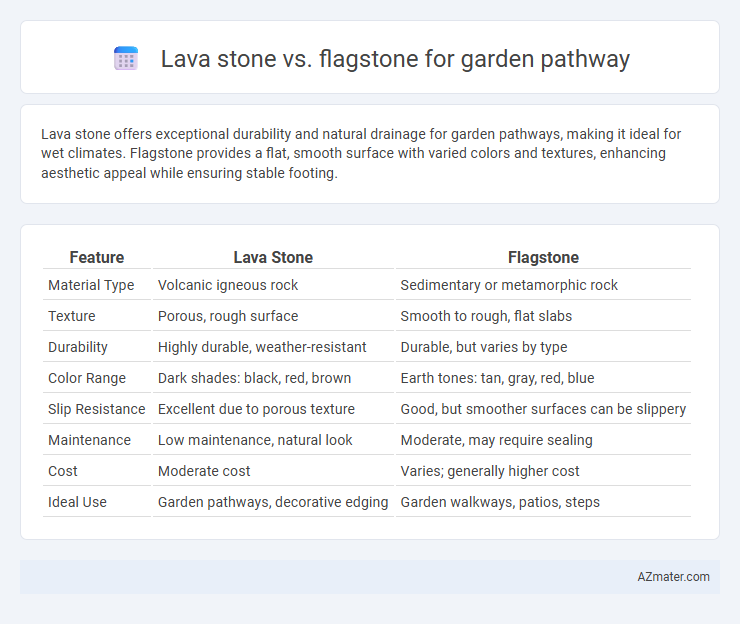Lava stone offers exceptional durability and natural drainage for garden pathways, making it ideal for wet climates. Flagstone provides a flat, smooth surface with varied colors and textures, enhancing aesthetic appeal while ensuring stable footing.
Table of Comparison
| Feature | Lava Stone | Flagstone |
|---|---|---|
| Material Type | Volcanic igneous rock | Sedimentary or metamorphic rock |
| Texture | Porous, rough surface | Smooth to rough, flat slabs |
| Durability | Highly durable, weather-resistant | Durable, but varies by type |
| Color Range | Dark shades: black, red, brown | Earth tones: tan, gray, red, blue |
| Slip Resistance | Excellent due to porous texture | Good, but smoother surfaces can be slippery |
| Maintenance | Low maintenance, natural look | Moderate, may require sealing |
| Cost | Moderate cost | Varies; generally higher cost |
| Ideal Use | Garden pathways, decorative edging | Garden walkways, patios, steps |
Introduction to Garden Pathway Materials
Lava stone offers a unique, porous texture and excellent durability, making it ideal for garden pathways that require slip resistance and heat retention. Flagstone, composed of flat sedimentary rocks, provides a natural, elegant appearance with varied colors and shapes that blend seamlessly into garden landscapes. Both materials withstand outdoor elements well, but lava stone's volcanic origin ensures higher resilience to heavy foot traffic and weather, while flagstone emphasizes aesthetic flexibility.
What is Lava Stone?
Lava stone, formed from cooled volcanic lava, is a porous and lightweight natural rock commonly used in garden pathways for its durability and unique texture. Unlike flagstone, which is a sedimentary rock known for its flat, smooth surfaces, lava stone offers superior drainage and heat retention properties, making it ideal for outdoor landscaping. Its rough, porous nature provides excellent traction, enhancing safety in garden paths while contributing an earthy, rustic aesthetic.
What is Flagstone?
Flagstone is a flat sedimentary rock, typically composed of sandstone, slate, or limestone, widely used for garden pathways due to its natural texture and durability. Its irregular shapes and varied colors create aesthetically pleasing, slip-resistant surfaces that blend seamlessly with outdoor landscapes. Unlike the porous and volcanic nature of lava stone, flagstone offers stronger structural integrity and a more even walking surface.
Aesthetic Appeal: Lava Stone vs Flagstone
Lava stone offers a unique, porous texture with deep, earthy tones that create a rugged, natural aesthetic ideal for modern or rustic garden pathways. Flagstone provides a smooth, flat surface with varied, subtle color patterns that enhance traditional and formal garden designs with timeless elegance. The choice between lava stone and flagstone ultimately depends on whether a bold, textured look or a refined, polished appearance is desired for the pathway.
Durability and Longevity Comparison
Lava stone offers exceptional durability due to its volcanic origin, making it resistant to cracking and weathering in garden pathways. Flagstone, while durable, is more prone to chipping and erosion over time, especially in freeze-thaw climates. Lava stone's porous yet strong composition typically ensures longer longevity and minimal maintenance compared to flagstone in outdoor garden environments.
Slip Resistance and Safety Factors
Lava stone offers excellent slip resistance due to its naturally rough and porous surface, making it safer for garden pathways, especially in wet conditions. Flagstone, while aesthetically pleasing, can become slippery when wet because of its smoother texture, requiring additional treatments or textured finishes to improve safety. Choosing lava stone enhances traction and reduces the risk of slips and falls, ensuring a safer outdoor walking environment.
Installation Process and Ease
Lava stone offers a relatively simple installation process due to its lightweight nature and uniform size, allowing for easy placement and leveling on garden pathways. Flagstone, being heavier and often irregularly shaped, requires more effort and skill to fit pieces tightly together and create a stable surface. Both materials benefit from a well-prepared base, but lava stone generally demands less time and labor, making it a preferred choice for DIY garden path projects.
Maintenance Requirements
Lava stone requires minimal maintenance due to its porous nature, which allows for excellent drainage and reduces weed growth, making it ideal for garden pathways. Flagstone, while aesthetically pleasing with a smooth surface, demands more upkeep such as regular sealing to prevent staining and frequent cleaning to avoid moss and algae buildup. Choosing lava stone can significantly reduce long-term maintenance efforts, while flagstone offers a more polished look but requires consistent care to maintain its appearance.
Cost Comparison
Lava stone offers a more budget-friendly option for garden pathways, with prices typically ranging from $3 to $7 per square foot, making it ideal for cost-conscious landscaping projects. Flagstone, known for its natural elegance, generally costs between $8 and $15 per square foot due to its durability and aesthetic appeal. Considering installation and maintenance, lava stone often results in lower overall expenses, while flagstone demands a higher upfront investment but provides long-term value.
Environmental Impact and Sustainability
Lava stone is a highly sustainable choice for garden pathways due to its natural, abundant volcanic origin and minimal processing requirements, resulting in a lower carbon footprint compared to flagstone. Flagstone, typically quarried from sedimentary rock, often involves energy-intensive extraction and transportation, increasing environmental impact. Both stones offer durability, but lava stone's porous nature aids in water drainage and reduces runoff, promoting eco-friendly garden design.

Infographic: Lava stone vs Flagstone for Garden pathway
 azmater.com
azmater.com